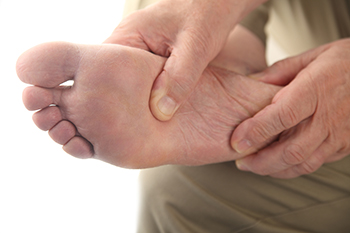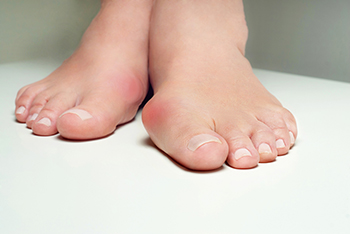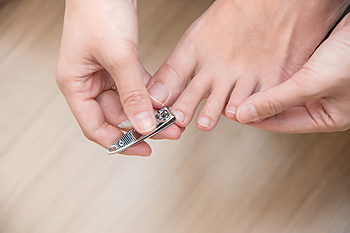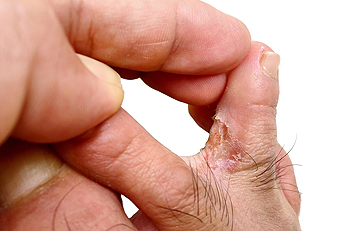
Wilmington (937) 382-2347
Fax
(513) 932-1606

Wilmington (937) 382-2347
Fax
(513) 932-1606

The importance of practicing exceptional foot care for diabetic patients is crucial in preventing dangerous foot wounds from developing. It is beneficial to implement a simple, daily foot care routine. These can include washing and drying the feet, followed by checking the soles for any cuts or bruises that may have happened. Many people find it helpful to use a mirror to accomplish this, or it can also be done with the help of a family member or caregiver. Diabetes is caused by elevated blood sugar levels, and many times can be controlled by implementing healthy eating habits. Additionally, it is suggested for diabetic patients to stop smoking, as this can contribute to foot wounds. The risk can be reduced for an ingrown toenail to develop by properly trimming the toenails once per week. If you have diabetes, it is strongly suggested that you are under the care of a podiatrist who can help you to manage this condition, and guide you toward additional foot care practices.
Diabetic foot care is important in preventing foot ailments such as ulcers. If you are suffering from diabetes or have any other concerns about your feet, contact Dr. Gerald Perelman from Ohio. Our doctor can provide the care you need to keep you pain-free and on your feet.
Diabetic Foot Care
Diabetes affects millions of people every year. The condition can damage blood vessels in many parts of the body, especially the feet. Because of this, taking care of your feet is essential if you have diabetes, and having a podiatrist help monitor your foot health is highly recommended.
The Importance of Caring for Your Feet
Patients with diabetes should have their doctor monitor their blood levels, as blood sugar levels play such a huge role in diabetic care. Monitoring these levels on a regular basis is highly advised.
It is always best to inform your healthcare professional of any concerns you may have regarding your feet, especially for diabetic patients. Early treatment and routine foot examinations are keys to maintaining proper health, especially because severe complications can arise if proper treatment is not applied.
If you have any questions please feel free to contact our office located in Wilmington, OH . We offer the newest diagnostic and treatment technologies for all your foot and ankle needs.

Bunions are all too common and affect all ages of people. They are more apt to happen to women, thought to be because of the pointy-toed, or high-heeled fashionable shoes they wear. However, they are not only caused by shoes, as bunions can happen to people in cultures who do not wear shoes. A bunion is a bony deformity of the big toe joint, also known as hallux valgus. When one has a bunion, their foot appears wider, and shoes can press on the painfully deformed joint. Pressure from the shoes pushes the big toe towards the second toe and the first joint bulges on the side of the foot. As the condition progresses, the second toe may lie over the top of the big toe, which leads to further pressure and distortion of footwear. Hard skin and corns may develop on the bunion and top of the second toe because they rub on shoes. This makes walking difficult, too. Bunions are easy to see. They are red, hot, painful, and swollen. A fluid-filled sac called a bursa sometimes develops over the joint to try and protect it from damage. Due to degenerative changes, arthritis might develop as well. If you suffer from a bunion, make sure to wear shoes that have enough room for the toes to move freely, with the bunion, and see a podiatrist for other suggestions and treatment options.
If you are suffering from bunions, contact Dr. Gerald Perelman of Ohio. Our doctor can provide the care you need to keep you pain-free and on your feet.
What Is a Bunion?
A bunion is formed of swollen tissue or an enlargement of boney growth, usually located at the base joint of the toe that connects to the foot. The swelling occurs due to the bones in the big toe shifting inward, which impacts the other toes of the foot. This causes the area around the base of the big toe to become inflamed and painful.
Why Do Bunions Form?
Genetics – Susceptibility to bunions are often hereditary
Stress on the feet – Poorly fitted and uncomfortable footwear that places stress on feet, such as heels, can worsen existing bunions
How Are Bunions Diagnosed?
Doctors often perform two tests – blood tests and x-rays – when trying to diagnose bunions, especially in the early stages of development. Blood tests help determine if the foot pain is being caused by something else, such as arthritis, while x-rays provide a clear picture of your bone structure to your doctor.
How Are Bunions Treated?
If you have any questions, please feel free to contact our office located in Wilmington, OH . We offer the newest diagnostic and treatment technologies for all your foot care needs.

Many individuals who are novices in podiatry might already be familiar with what it means to file the nails. Typically, individuals use nail files on their fingernails to file down the tips of the nail and form the shape. Many people may be surprised to know that nail files can also be used on the toenails. Nail files are also known as emery boards. When using the emery board on the toenails, it is important to remember to keep the board perpendicular to the toenail. Additionally, the emery board should not be moved back and forth over the nail. Typically, moving the emery board in one direction during the filing process is best. Also, it is not a good practice to file the toenails at an angle, as this can make the nails have an uneven, rounded shape. Additionally, it can put an individual at an increased risk of developing an ingrown toenail. If you have any questions about filing the toenails and everyday foot care tips, contact a podiatrist today.
Everyday foot care is very important to prevent infection and other foot ailments. If you need your feet checked, contact Dr. Gerald Perelman from Ohio. Our doctor can provide the care you need to keep you pain-free and on your feet.
Everyday Foot Care
Often, people take care of their bodies, face and hair more so than they do for their feet. But the feet are a very important aspect of our bodies, and one that we should pay more attention to. Without our feet, we would not be able to perform most daily tasks.
It is best to check your feet regularly to make sure there are no new bruises or cuts that you may not have noticed before. For dry feet, moisturizer can easily be a remedy and can be applied as often as necessary to the affected areas. Wearing shoes that fit well can also help you maintain good foot health, as well as making it easier to walk and do daily activities without the stress or pain of ill-fitting shoes, high heels, or even flip flops. Wearing clean socks with closed shoes is important to ensure that sweat and bacteria do not accumulate within the shoe. Clean socks help to prevent Athlete’s foot, fungi problems, bad odors, and can absorb sweat.
If you have any questions please feel free to contact our office located in Wilmington, OH . We offer the newest diagnostic and treatment technologies for all your foot and ankle needs.

Snowboarding can be dangerous, and injuries are common for those who participate in this sport. While there are ways to prevent such injuries, there are no guarantees that they will not happen. In snowboarding, it is possible to roll an ankle or twist a foot in a way that leads to mild or severe injuries. A sprained ankle is a frequent injury in this sport. It can result from landing awkwardly on the board or wearing boots that do not fit as well as they should. It can also happen as part of a knee injury. Sprained or bruised heels can also happen in snowboarding. For example, a bruised heel can occur when one goes off of a jump and lands hard. Snowboarding within one’s ability can help prevent ankle and foot injuries. Wearing properly fitting boots is also suggested to limit risk of injuries. If you have hurt your feet or ankles while snowboarding, see a podiatrist as soon as you can for diagnosis and treatment.
Ankle and foot injuries are common among athletes and in many sports. They can be caused by several problems and may be potentially serious. If you are feeling pain or think you were injured in a sporting event or when exercising, consult with Dr. Gerald Perelman from Ohio. Our doctor will assess your condition and provide you with quality foot and ankle treatment.
Common Injuries
The most common injuries that occur in sporting activities include:
Symptoms
Symptoms vary depending upon the injury and in some cases, there may be no symptoms at all. However, in most cases, some form of symptom is experienced. Pain, aching, burning, bruising, tenderness, tightness or stiffness, sensation loss, difficulty moving, and swelling are the most common symptoms.
Treatment
Just as symptoms vary depending upon the injury, so do treatment options. A common treatment method is known as the RICE method. This method involves rest, applying ice, compression and elevating the afflicted foot or ankle. If the injury appears to be more serious, surgery might be required, such as arthroscopic or reconstructive surgery. Lastly, rehabilitation or therapy might be needed to gain full functionality in the afflicted area. Any discomfort experienced by an athlete must be evaluated by a licensed, reputable medical professional.
If you have any questions, please feel free to contact our office located in Wilmington, OH . We offer the newest diagnostic and treatment technologies for all your foot care needs.

Athlete’s foot is primarily caused by a fungal infection. Athlete’s foot can produce a scaly rash of some kind, often producing itching sensations. Athlete’s foot can be spread in highly-trafficked public areas such as the sides of public pools and locker rooms. Importantly, however, athlete’s foot can be spread through using towels. If an individual with athlete’s foot uses a towel after taking a shower and then an uninfected person uses the towel, the second person will have a high risk of developing athlete’s foot. Therefore, if you live with someone, it might be a good idea to have separate towels for each individual to avoid this dilemma. It might also be useful to make a point of cleaning the towels every day. This can help ensure that the athlete’s foot is not being unnecessarily spread. Contact a podiatrist today for more information.
Athlete’s foot is an inconvenient condition that can be easily reduced with the proper treatment. If you have any concerns about your feet and ankles, contact Dr. Gerald Perelman from Ohio. Our doctor will treat your foot and ankle needs.
Athlete’s Foot: The Sole Story
Athlete's foot, also known as tinea pedis, can be an extremely contagious foot infection. It is commonly contracted in public changing areas and bathrooms, dormitory style living quarters, around locker rooms and public swimming pools, or anywhere your feet often come into contact with other people.
Solutions to Combat Athlete’s Foot
Athlete’s foot can cause many irritating symptoms such as dry and flaking skin, itching, and redness. Some more severe symptoms can include bleeding and cracked skin, intense itching and burning, and even pain when walking. In the worst cases, Athlete’s foot can cause blistering as well. Speak to your podiatrist for a better understanding of the different causes of Athlete’s foot, as well as help in determining which treatment options are best for you.
If you have any questions please feel free to contact our office located in Wilmington, OH . We offer the newest diagnostic and treatment technologies for all your foot and ankle needs.